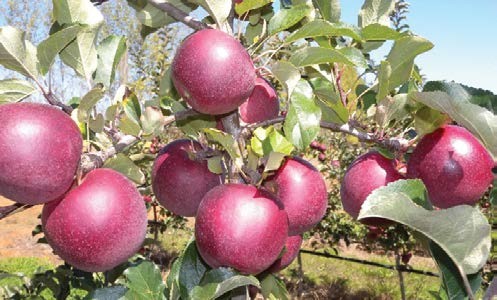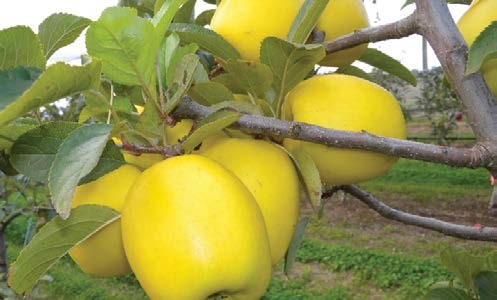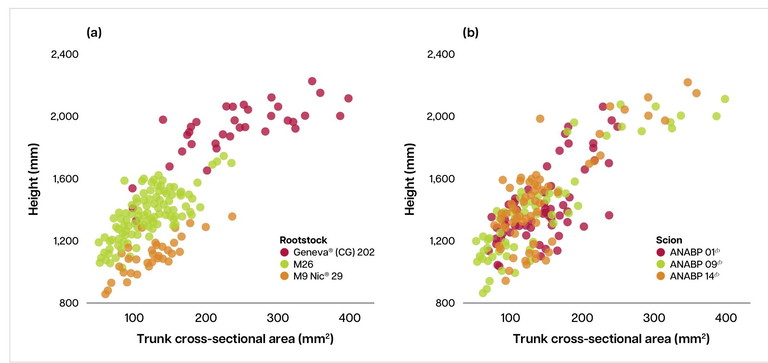POMEWEST narrow orchard systems
WA Narrow Orchard Systems
ROOTSTOCK EFFECT ON NURSERY TREE SIZE
Project update
The Department of Primary Industries and Regional Development (DPIRD) is evaluating 2D multileader narrow orchard systems as a part of the five-year national Narrow Orchard Systems project (NOS).
Words Muhammad Asad Ullah, Shuangxi Zhou and Dario Stefanelli, Research Scientists, Department of Primary Industries and Regional Development
THREE Australian bred apples (‘ANABP 01 A ’, ‘ANABP 09 A ’, ‘ANABP 14 A ’; Figure 1) grafted on three rootstocks of different vigour — semi-dwarfing (Geneva® (CG) 202) and dwarfing (M26 and M9 Nic® 29) rootstocks — will be investigated on double cordon production system.
The orchard planted at the Manjimup Horticultural Research Institute has 2 m tree spacing and 2.5 m row spacing. This article provides an overview and significance of size differences among nursery produced trees of the nine scion-rootstock combinations.
The plants were budded by a local nursery in February 2023 and planted in September 2024 when the trees were one year and seven months old. Three weeks after planting, the height and trunk cross-sectional area (TCSA; measured at 21 cm above the grafting unit) of each tree were measured for a total of 216 data trees. Tree height and TCSA were mainly affected by the different rootstocks (Figure 2a) but not the cultivar type (Figure 2b).



FIGURE 1: Three apple cultivars (top: ‘ANABP 01 A ’, middle: ‘ANABP 09 A ’, above: ‘ANABP 14 A ’) with distinct market-oriented characteristics bred by the Australian National Apple Breeding Program.

FIGURE 2: Height and trunk cross-sectional area of (a) trees grafted on three rootstocks (left plot): the semi-dwarfing Geneva ® (CG) 202 rootstock (red), the dwarfing M26 (green) and M9 Nic ® 29 (orange) rootstocks; and of (b) three apple cultivars (right plot): ‘ANABP 01A ’ (red), ‘ANABP 09A ’ (green) and ‘ANABP 14A ’ (orange).
Trees (irrespective of cultivar) grafted on semi-dwarfing CG 202 rootstock had higher TCSA and were taller compared to dwarfing rootstocks (M26 and M9). Trees on M26 rootstock were taller than trees on M9 rootstock with similar TCSA values (Figure 2 left). This indicates how the quality of nursery produced trees are affected by rootstock, which could potentially translate into quick canopy fill, early fruiting and returns on investment.
In general, rootstocks provide an ideal way to control vigour, improve disease resistance, and tree water and nutrient relationships. For optimal fruit quality and yield, an understanding of the compatibility between scion and rootstock is required.
An optimal rootstock × scion combination provides numerous advantages, not only enhancing orchard management and fruit production but also contributing to overall sustainability benefits. Other key benefits include:
• Resistance to diseases from soil-borne pathogens
• Improved water and nutrient use efficiency
• Climate resilience through tolerance to abiotic stresses
• Improved fruit quality and early yields to enhance overall profitability
• Dwarfing effect to make orchard management (e.g., pruning, harvest) easier and reduce labour costs.
The Western Australian NOS project team will evaluate, over the next four years, the differential response of rootstock × scion interactions on water and nutrient use efficiency, tree growth parameters, yield and most importantly fruit quality. Combined with economic analysis, the project aims to deliver a complete best practice package to Australian apple growers.
Acknowledgements
Narrow orchard systems for future climates is funded through Hort Innovation Frontiers with co-investment from Agriculture Victoria, NSW Department of Primary Industries and Regional Development, South Australian Research and Development Institute, Department of Primary Industries and Regional Development WA, University of Queensland, Pomewest, Tobias Industries, and contributions from the Australian Government.